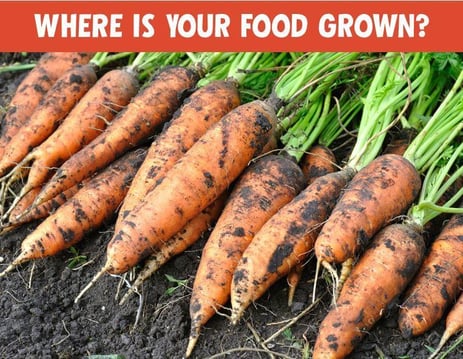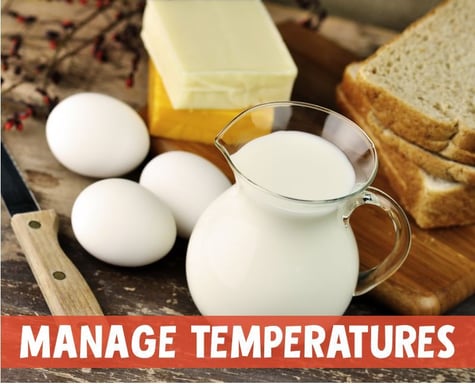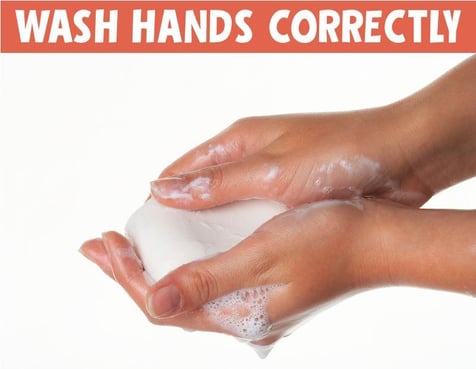September is National Food Safety Month! Food safety is one of the most important values Great Harvest Franchising instills in our bakeries; it’s a bakery fundamental with no room for error. Recently our entire franchise field staff completed the ServeSafe Manager Certification course; for most of us, this was a re-up on a previous certification. ServeSafe was created by the National Restaurant Association, foodservice industry leaders. It is the most widely adopted food safety standard in the United States; thus, it is the standard we recommend to our franchisees.
There are many techniques for safe food handling, but ServeSafe identifies five major ways food can become unsafe ─ both at home and in food service establishments ─ and has guidelines for how to overcome them. These risk factors are imperative to understand if you are in commercial food service and also important to understand if you frequently cook in your home. Fortunately, most major risk factors for unsafe food can be managed with common sense caution.
Food Safety Starts in the Field
 The first major risk factor for unsafe food is purchasing food from unsafe sources. To avoid this in a food service establishment, we only purchase food from licensed and reputable vendors. Although I may have had a wonderful zucchini crop in my garden this year, a reputable bakery wouldn’t buy my crop to make zucchini bread because I’m not licensed to sell products from my garden. There is no regulation over the pesticides, fertilizers, chemicals and growing practices I use in my personal garden. Accordingly, even though I’m happy feeding them to myself and my family, my garden goodies shouldn’t be passed along to a licensed foodservice establishment.
The first major risk factor for unsafe food is purchasing food from unsafe sources. To avoid this in a food service establishment, we only purchase food from licensed and reputable vendors. Although I may have had a wonderful zucchini crop in my garden this year, a reputable bakery wouldn’t buy my crop to make zucchini bread because I’m not licensed to sell products from my garden. There is no regulation over the pesticides, fertilizers, chemicals and growing practices I use in my personal garden. Accordingly, even though I’m happy feeding them to myself and my family, my garden goodies shouldn’t be passed along to a licensed foodservice establishment.
In your own home, you can buy your ingredients from whoever you want. You absolutely can accept those zucchinis from your friend’s garden – just use common sense caution (see FDA info on selecting and serving fresh produce). If products appear to be moldy or old, don’t use them. If you’re at the farmer’s market and shellfish or fish appear slimy, have a bad odor or have open shells, don’t buy them. Common sense goes a long way.
Food Must Be Cooked Correctly
Failing to cook food correctly is a major issue in both the home and in a foodservice establishment. The most important pillar of cooking food appropriately is cooking it to the appropriate temperature. The following table outlines the Serve Safe guidelines for appropriate cooking temperatures for items we commonly cook.
Minimum Internal Temperature |
Type of Food |
| 165°F (74°C) for 15 seconds | • Poultry – including whole or ground chicken, turkey or duck • Stuffing made with fish, meat or poultry • Stuffed meat, seafood, poultry or pasta • Dishes that include previously cooked TCS (time and temperature controlled for safety) ingredients (raw ingredients should be cooked to their minimum internal temperatures) |
| 155°F (68°C) for 15 seconds | • Ground meat – including beef, pork and other meat • Injected meat – including brined ham and flavor-injected roasts • Mechanically tenderized meat • Ratites – including ostrich and emu • Ground seafood – including chopped or minced seafood • Shell eggs that will be hot-held for service |
| 145°F (63°C) for 15 seconds | • Seafood – including fish, shellfish, and crustaceans • Steaks/chops of pork, beef, veal and lamb • Commercially raised game • Shell eggs that will be served immediately |
| 145°F (63°C) for 15 seconds | • Roasts of pork, beef, veal and lamb |
| 135°F (57°C) for 15 seconds | • Fruit, vegetables, grains (rice, pasta) and legumes (beans, refried beans) that will be hot-held for service |
Avoid Time Temperature Abuse
Holding food at incorrect temperatures is one of the most abused pillars of food safety (see FDA info on food storage). Serve Safe defines food in which pathogens grow well as “TCS foods” – foods requiring time and temperature control for safety. It is imperative TCS foods are stored properly.
The most common TCS foods include:
- milk and dairy products
- beef, pork and lamb
- fish
- baked potatoes
- tofu or other soy protein
- sliced melons
- cut tomatoes
- cut leafy greens
- shell eggs
- poultry
- shellfish and crustaceans
- heat-treated plant foods such as:
- cooked rice
- beans and vegetables
- sprouts and sprout seeds
- untreated garlic-and-oil mixtures
 Bacteria is the most common cause of foodborne illness and grows most rapidly between 41°F and 135°F (5°C and 57°C). This range is known as the temperature danger zone. Bacteria grow even more rapidly from 70°F to 125°F (21°C and 52°C). Bacteria growth is limited when food is held above or below the temperature danger zone.
Bacteria is the most common cause of foodborne illness and grows most rapidly between 41°F and 135°F (5°C and 57°C). This range is known as the temperature danger zone. Bacteria grow even more rapidly from 70°F to 125°F (21°C and 52°C). Bacteria growth is limited when food is held above or below the temperature danger zone.
All TCS foods should be kept out of the temperature danger zone as long as possible. If they are stored in the temperature danger zone for a cumulative period of longer than four hours, they should be thrown out. So if you’re running errands, make your stop at the grocery store your last one! The time spent transporting your groceries from the refrigeration at the grocery store to the refrigerator in your kitchen can count as time in the temperature danger zone where you are exposing your food to bacteria growth. You may also want to consider a cooler with ice packs when making a longer trip with TCS food.
Keep Your Work Area Clean
Using contaminated equipment can easily lead to food becoming unsafe. Dirty cooking surfaces can lead to biological, chemical and physical contamination of foods. Biological contamination comes from bacteria, viruses, parasites and fungi such as Salmonella, Hepatitis A and Norovirus. Chemical contamination occurs when chemicals, often cleaning supplies, come in contact with foods. Physical contaminants are items such as metal shards from opening cans, bones left in fish or shattered pieces of glass from a broken dish. Keeping a clean work area can prevent these major contaminations.
The primary steps to keeping work areas clean involve washing, rinsing and sanitizing. Washing cleans and removes physical contaminates from a work surface. Rinsing removes the chemicals from the washing process and any excess debris. Sanitizing uses either a food-safe chemical or heat to remove bacteria from the work surface. Remember, even in the home, washing alone doesn’t remove bacteria. In your home, try to use a dishwasher or a chemical sanitizer to clean up dishes or prep surfaces used for handling potentially hazardous foods.
Wash Your Hands!
 Last, but certainly not least, practicing poor hygiene ─ namely, not washing your hands ─ is the number one contributor to foodborne illness. A Michigan State University study published in the Journal of Environmental Health in 2013 (pdf) found that only 5% of people washed their hands correctly.
Last, but certainly not least, practicing poor hygiene ─ namely, not washing your hands ─ is the number one contributor to foodborne illness. A Michigan State University study published in the Journal of Environmental Health in 2013 (pdf) found that only 5% of people washed their hands correctly.
Follow the following steps to wash your hands properly:
1. Wet hands and arms. Use running water as hot as you can comfortably stand. It should be at least 100°F (38°C).
2. Apply soap. Apply enough to build up a good lather.
3. Scrub hands and arms vigorously. Scrub them for 10 to 15 seconds. Clean under fingernails and between fingers.
4. Rinse hands and arms thoroughly. Use running warm water.
5. Dry hands and arms. Use a single-use paper towel or a hand dryer.
You should wash your hands after the following situations:
• Using the restroom!
• Handling raw meat, poultry and seafood.
• Touching your hair, face or body.
• Sneezing, coughing or using a tissue.
• Eating, drinking, smoking or chewing gum or tobacco.
• Handling chemicals that may affect food safety.
• Taking out garbage.
• Changing tasks.
• And many more – when in doubt, wash your hands!
There is so much more you can and should do to safely handle food ─ both in a food service establishment and in your home.
Check out these other resources about food safety to learn more:
• Food Safety from A to Z (FDA's Food Facts for Consumers)
• Safe Food Handling: What you Need to Know (FDA)
• Debunking Myths about Safe Food Refrigeration (Foodsafety.gov)
Food safety is one of many things we train bakery owners on. Learn more:
Read More About Food Safety on The Bread Business Blog:
• How Do I Safety Use Holiday Leftovers?





